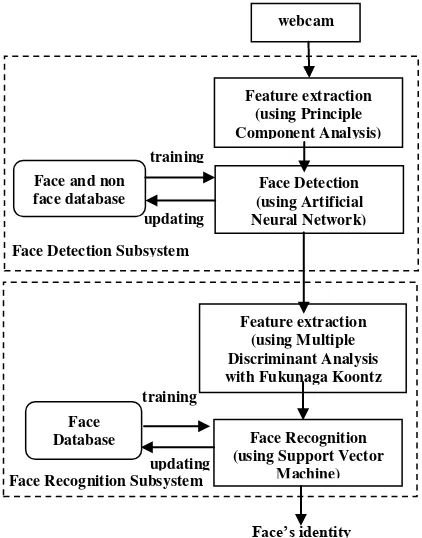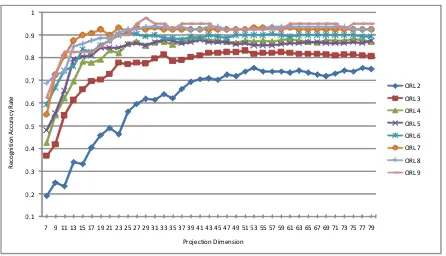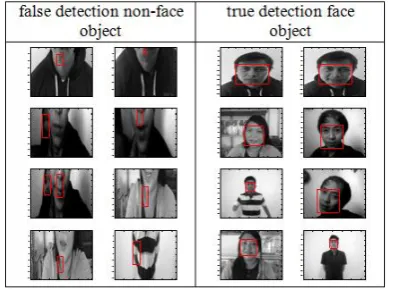63
MULTIPLE DISCRIMINANT ANALYSIS WITH FUKUNAGA KOONTZ
TRANSFOR AND SUPPORT VECTOR MACHINE
FOR IMAGE-BASED FACE DETECTION AND RECOGNITION
a
Sri Andriati Asri,
bWidyadi Setiawan a
Electrical Engineering Dept., Bali State Polytechnic, Bukit Jimbaran, Kuta Selatan, Badung, Bali
b
Electrical Engineering Dept., Faculty of Engineering Udayana University, Bukit Jimbaran, Kuta Selatan, Badung, Bali 80361
E-Mail: [email protected]
Abstrak
Pengenalan wajah dapat diterapkan pada banyak aplikasi potensial, seperti otentikasi identitas, information security, surveillance dan interaksi manusia komputer. Penelitian ini bertujuan membangun perangkat lunak berbasis Matlab untuk deteksi dan pengenalan wajah dengan masukan berupa citra. Sistem yang akan dibangun
meliputi deteksi dan pengenalan wajah. Subsistem Deteksi Wajah memakai Principle
Component Analysis (PCA) sebagai ekstraksi fitur dan Jaringan Syaraf Tiruan Perambatan Balik sebagai pengklasifikasinya. Pada Subsistem Pengenalan Wajah
memakai metode Support Vector Machine salah satu algoritma kecerdasan buatan
yang mampu mengklasifikasikan banyak wajah dengan baik. Metode Multiple
Discriminant Analysis with Fukunaga Koontz Transform (MDA/FKT) dipakai sebagai ekstraksi fitur. Pelatihan dan pengujian sistem memakai basis data penelitian, dan basis data standar yaitu basis data ORL sebagai pembanding. Rancang bangun Aplikasi Deteksi dan Pengenalan Wajah telah berhasil diselesaikan pada penelitian ini. Subsistem Deteksi Wajah menghasilkan tingkat keakuratan pendeteksian wajah sebesar 99 %. Pada Subsistem Pengenalan Wajah, tingkat pengenalan basis data penelitian (UNUD) 82,76 %, sedangkan tingkat pengenalan pada basis data ORL 97,5%.
Kata kunci: Deteksi Wajah, Pengenalan Wajah, Support Vector Machine, Multiple
Discriminant Analysis with Fukunaga Koontz Transform.
Abstract
Face recognition can be applied to many potential applications, such as identity authentication, information security, surveillance and human computer interaction. This research aims to build a Matlab-based software for face detection and recognition application using an image input form. The system consist of face detection and recognition subsystem. Face detection subsystem using PCA as feature extraction and Back Propagation Neural Network as its classifier. In face recognition subsystem using Support Vector Machine as known as one of the good methods in the artificial intelligence algorithm that is able to classify many faces well. Multiple Discriminant Analysis Method with Fukunaga Koontz Transforms (MDA / FKT) is used as feature extraction. Training and Testing database systems using research (UNUD) database, and ORL database as a comparison. Face detection and recognition application has been successfully completed in this research, face detection subsystem produces face detection accuracy rate of 97.95 %, and for face recognition subsystem, the recognition rate is 82.76 % on research (UNUD) database, while the recognition rate on ORL database is 97.5 %.
INTRODUCTION
Image segmentation as one of the methods in digital image processing intends to generate an abstraction of the input in a digital image. Face detection is trying to identify the features of faces to detect the faces based on discriminant features. Face detection is used to find the location of the face in an image. The face
detection process’s result is very important for
identification or face recognition process. The output of face detection focused on someone's face with eyes, nose, chin, lips, etc. these are known as features of face. In which each individu had different or unique features of face. Face detection process can also eliminated hair variation for each individu. There are several methods for classification of data. Linear Discriminant Analysis (LDA) and Principle Component Analysis (PCA) most commontly used to reduced dimension and data classification. These technique can be used for feature extractor or face detection [1]. Many there were feature extraction and classification process. Feature extraction will generated the essential features of every image or data. Once it generated, these features will be used for the classification process. This paper used Multiple Discriminant Analysis with Fukunaga Koontz Transform (MDA/FKT), becaused this technique can still working even the worst case occurs when the classes had the same mean [3]. The classification process used Support Vector Machine (SVM). SVM used a function or hyper plane to separate two classes of patterns. SVM will try to find the optimal hyper plane pattern where two classes can be seperated maximally. SVM is a binary classifier, but SVM can also be used for many problems of class or multi-class problem. Face recognition is multi-class problem [4]. The SVM classifier has good robustness and regularization [5]. SVM has high generalization capabilities in several applications, including the application of face recognition. Face recognition using SVM no pre-processing image required to enhance the recognition accuracy [6].
This research tried to combined those
classes, the autocorelation matrices are
S1=A1A1 symmetric, and can be factorized in the form as seen in Equation (1).
class scatter matrix, St is total scatter matrix.
Figure 1. The whole data is decomposed into four subspaces [3].
MULTIPLE DISCRIMINANT
ANALYSIS WITH FUKUNAGA
KOONTZ TRANSFORM (MDA/FKT)
In Linear Discriminant Analysis its can happen
the worst case, when all the classes have the
fail. Subspace 1 and 2 do not exist, only the subspace 3 and 4, wich are less descriminative. To handles this problem, the multiclass casts as a binary classification problem using a
formulationΔ = ai – aj and defines theintraclass
ΩI = {( ai – aj)│L(ai) = L(aj)} and the space
extraclassΩE = {( ai – aj)│L(ai) ≠L(aj)}, where
L(ai) is the class label ai.
Multiple Discriminant Analysis with Fukunaga Koontz Transform has several unique features, this methods can be provide more then C-1 discriminant eigenvector, because usually rank
Iand
E is higher thanC-1.
SUPPORT VECTOR MACHINE
SVM method was first developed by Vapnik, and becoming more popular because SVM has attractive features and promising empirical performance. SVM work on the principle of Structural Risk Minimization (SRM) which is the opposite of the principle of Empirical Risk Minimization (ERM). SRM minimizes an upper limit on the Vapnik-Chervonenkis dimension (VC dimension) or generalization error, while ERM minimizes the error of the training data. SVM can dealing with linear separable and non linear separable data [8].
SYSTEM DESIGN
System design is shown in Figure 2. The input of the system is a face image catched by a web camera. The system will process the input to produce the final output, which is the identity
of the face’s owner.
Face detection and face recognition
subsystem is shown in Figure 3 and Figure 4. It can be broadly divided into 3 main processes, which are preprocessing, feature extraction and classification. Each face database used in this research divided into two portions, one portion is used for the training process and the rest is used for the testing process.
Preprocessing is the process of collecting data and data normalization.The face data must be in the gray scale image form, if the face image still in the color form, it needs the process to changes the image into a gray scale image.
Figure 2. Face Detection and Recognition System Design.
Figure 3. Face Detection Subsystem.
Figure 4. Face Recognition Subsystem.
Preprocessing is the process of collecting data and data normalization.The face data must be in the gray scale image form, if the face image still in the color form, it needs the process to changes the image into a gray scale image. Normalization is used to reduce the size of the face image and get ideal enough to be used as input data by cropping the image to obtain ideal form to be used as input data [9]. Ideally the face image is composed of the eyes, nose and mouth as well as background and hair that most have been removed, in addition to reducing the size of the image. In the implementation process or when the program is
executed, sometimes that’s need to resize the
input image into a half or a quarter of the real size of the input image. A big size of input face can makes the resulting vector large, and it also requires a large memory capacity.
Feature extraction using Multiple
Discriminant Analysis with Fukunaga Koontz Transform. Features of an object in the same category has similar value.
This phase aims to obtain a set of feature vectors will be used for the classification phase. The image from preprocessing is an input for feature extraction process. At the initial stage
of the feature extraction process, a data input n
x m dimensions will be transformed onto face
vector with (n x m) x 1 dimensions or a
column vector. The results of the feature extraction process is a vector of features with smaller dimensions (called as dimensions projection). For Multiple Discriminant Analysis
with Fukunaga Koontz Transform, the
maximum dimensions projection of its vector
is (rank (Ht)) x1, whereas for Linear
Discriminant Analysis the maximum
dimensions projection is (C-1) x 1 (C is number
of classes in a database ) [3].
Classification process is performed after the
feature extraction. special features that
produced such a vector called faeture vector with small dimensions. In the face recognition phase, SVM classification process is divided into two stages, wich are training and testing process. To seek support vector of input data in each training process used a quadratic programming [10].
RESULT AND DISCUSSION
Face Database on this research is used to testing the face detection subsystem and face
recognition subsystem. There are 3 face databases that will be used in this research, i.e., first, CBCL database (Center for Biological and Computational Learning). This database is used on the face detection subsystem training process (used to obtain PCA projection vectors and Back Propagation Neural Network who have completed the training process), with details of 2429 face images and 4548 non-face image with 19x19 dimensions. Second, the
face database ORL (Olivetti Research
Laboratory) Consists of 40 people, each people having 10 face images with 112 x 92 dimensions. This database is used in face detection subsystem (testing process) and face recognition subsystem (training and testing process). Third, research database (UNUD database), consists of 60 people, each people having 10 face images with of 480 x 640 dimensions. This database is used in face detection subsystem (testing process) and face recognition subsystem (process training and testing).
Face Detection Sub System Training
Process
In the Training Process of face detection subsystem with the CBCL database contains of 2429 face images and 4548 non face images with 19x19 dimensions. The searching process is using a 19x19 dimensions histogram equalization. To reduce dimensions further, this research is using PCA (Principle Component Analysis), the PCA changed the dimensions from 361 (19x19) to 40 major components. Face/non-face database used in this research will produced projection vectors with 40 main components. Overall the process is using 2429 face vectors and 4548 non face vectors. Thus will generated initial vectors of 6977x361 dimensions, and projection vector PCA with 361x40 deminsions. The next process is doing the classification into face and non-face class using Back Propagation Neural Network with 4 layers: input layer (40 neurons), the first hidden layer (20 neurons), the second hidden layer (10 neurons) and output layer (1 neuron).
Face Detection Sub System Testing
Process
image is converted to gray scale format. The downscale process is using the Haar Wavelet Transform (Haar Transform) which have 80x60 dimensions. This method also used to eliminating high frequency noise from the image. Gaussian filter is used to smoothing the image. The searching process is using a 19x19 dimensions histogram equalization. The PCA projection vectors that produced in training process with 361x40 dimensions use to projected the face image of 19 x 19 dimensions. The next process is the classification into face and non-face class using Back Propagation Neural Network which has resulted in the training process. The face detection subsystem testing are shown in Table 1. Face detection subsystem accuracy rate is 97.95%.
Accuracy rate is 99 % for face object, and 96.9 % for non-face object. We conclude that our face detection subsystem accuracy rate is 97.95 %. The face and non-face ORL database has better accuracy than UNUD database. The reasons is ORL database has less variation than UNUD database, such as light intensity, background, angle of object. The UNUD database has few limitations, such the object
taken with varying intensity, various
background, various angle of face. For the false detection non-face object, it cause by feature of intensity of the sub-image is close enough to sample that we use for training face detection subsystem.
Table 1. Face Detection Subsystem Testing Result.
Training and Testing Results Face
Recognition Subsystem for Database
ORL
percentage of successed recognition.0.1
Training and Testing Results Face
Recognition Subsystem for Database
UNUD
Figure 6 shows the recognition accuracy rate graphs for each test variation on the method research database with MDA/FKT. It indicates clearly that when the number of training samples per class and the projection dimensions increase, it will raise the percentage of recognition results. Figure 7 shows example for false and true detection.
Figure 6. Recognition accuracy rate for each of face detection subsystem is 97.95 %.
Figure 7. Example of False and True Detection
Maximum recognition rate can be achieved by MDA/FKT method is 97.5% for ORL database (on the test: 9 and 29 projection dimension) and 82.76% for research database (on test: 9 and 53 projection dimension)
.
ACKNOWLEDGEMENT
We would like to thanks to Center for Research and Community Services of Bali State
Polytechnic and Research Center and
Community Services of Udayana University.
REFERENCES
[1] A. Khan and H. Farooq, “Principal
Component Analysis-Linear Discriminant Analysis Feature Extractor for Pattern
Recognition,” IJCSI International Journal
of Computer Science Issues, vol. 8, no 2, pp. 267-270, 2011.
[2] S. Shende and R. Patel, “Efficient Face
Detection using PCA and ANN
Techniques,” International Journal on
Advanced Computer Theory and Engineering (IJACTE), vol. 2, no. 5, pp. 155-159, 2013.
[3] S. Zhang and T. Sim, “Discriminant
Subspace Analysis: A Fukunaga Koontz
Approach,” IEEE Transaction On Pattern
Analysis and Machine Intelligence, vol. 29, no 10, pp 1732-1745, 2007.
[4] Y. Liu, R. Wang, Y. Zeng, and H. He,
“An Improvement of One-against-all
Method for Multiclass Support Vector
Machine,” in Proceedings of 4th
International Conference: Sciences of Electronic, Technologies of Information and Telecommunications, Hongkong, 2007.
[5] H. Xu, C. Caramanis, and S. Mannor,
“Robustness and Regularization of
Support Vector Machines,” Journal of
Machine Learning Research, vol. 10, pp. 1341-1366, 2009.
[6] P. Harshangi and K. George, “Robustness
of A Face-Recognition Technique Based
On SupportVector Machines,” ICTACT
Journal On Image And Video Processing, August 2010, vol. 1, no.1, pp. 50-56, 2010.
[7] K. Fukunaga, Introduction to Statistical
Pattern Recognition Second Edition. Massachusetts: Academic Press, 1990.
[8] J.C. Burges, “A Toturial on Support
Vector Machines for Pattern Recognition,”
Data Mining and Knowledge Discovery,
vol. 2, no. 2, pp. 955-974,1998.
[9] R. Duda, P. Hart, and D. Stork, Pattern
Recognition, Second edition. New Jersey: J. Wiley and Sons, Inc., 2000.
[10] C.C. Chang and C.J. Lin, LIBSVM: a
![Figure 1. The whole data is decomposed into four subspaces [3].](https://thumb-ap.123doks.com/thumbv2/123dok/4036447.1979867/2.595.290.490.525.621/figure-data-decomposed-subspaces.webp)


